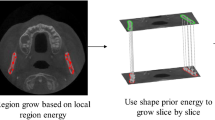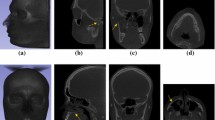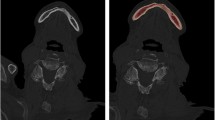Abstract
Purpose Extraction of the mandible from 3D volumetric images is frequently required for surgical planning and evaluation. Image segmentation from MRI is more complex than CT due to lower bony signal-to-noise. An automated method to extract the human mandible body shape from magnetic resonance (MR) images of the head was developed and tested.
Methods Anonymous MR images data sets of the head from 12 subjects were subjected to a two-stage rule-constrained region growing approach to derive the shape of the body of the human mandible. An initial thresholding technique was applied followed by a 3D seedless region growing algorithm to detect a large portion of the trabecular bone (TB) regions of the mandible. This stage is followed with a rule-constrained 2D segmentation of each MR axial slice to merge the remaining portions of the TB regions with lower intensity levels. The two-stage approach was replicated to detect the cortical bone (CB) regions of the mandibular body. The TB and CB regions detected from the preceding steps were merged and subjected to a series of morphological processes for completion of the mandibular body region definition. Comparisons of the accuracy of segmentation between the two-stage approach, conventional region growing method, 3D level set method, and manual segmentation were made with Jaccard index, Dice index, and mean surface distance (MSD).
Results The mean accuracy of the proposed method is \(0.958 \,\pm \, 0.020\) for Jaccard index, \(0.979 \,\pm \, 0.011\) for Dice index, and \(0.204 \,\pm \, 0.127\) mm for MSD. The mean accuracy of CRG is \(0.782 \,\pm \, 0.080\) for Jaccard index, \(0.876 \,\pm \, 0.053\) for Dice index, and \(0.417 \,\pm \, 0.073\) mm for MSD. The mean accuracy of the 3D level set method is \(0.874 \,\pm \, 0.0.051\) for Jaccard index, \(0.645 \pm 0.306\) for Dice index, and \(0.645 \pm 0.306\) mm for MSD. The proposed method shows improvement in accuracy over CRG and 3D level set.
Conclusion Accurate segmentation of the body of the human mandible from MR images is achieved with the proposed two-stage rule-constrained seedless region growing approach. The accuracy achieved with the two-stage approach is higher than CRG and 3D level set.








Similar content being viewed by others
References
Adams R, Bischof L (1994) Seeded region growing. IEEE Trans Pattern Anal Mach Intell 16:641–647
Bourgeat P, Fripp J, Stanwell P, Ramadan S, Ourselin S (2007) MR image segmentation of the knee bone using phase information. Med Image Anal 11:325–335
Dogdas B, Shattuck DW, Leahy RM (2005) Segmentation of skull and scalp in 3-D human MRI using mathematical morphology. Hum Brain Mapp 26:273–285
Dokldal P, Bloch I, Couprie M, Ruijters D, Urtasun R, Garnero L (2003) Topologically controlled segmentation of 3D magnetic resonance images of the head by using morphological operators. Pattern Recognit 36:2463–2478
Fabijaska A (2009) Two-pass region growing algorithm for segmenting airway tree from MDCT chest scans. Comput Med Imaging Graph 33:537–546
Kim DY, Chung SM, Park JW (2006) Automatic navigation path generation based on two-phase adaptive region-growing algorithm for virtual angioscopy. Med Eng Phys 28:339–347
Lorigo LM, Faugeras OD, Grimson WEL, Keriven R, Kikinis R (1998) Segmentation of bone in clinical knee MRI using texture-based geodesic active contours. MICCAI, pp 1195–1204
Park JG, Lee C (2009) Skull stripping based on region growing for magnetic resonance brain images. NeuroImage 47:1394–1407
Rifai H, Bloch I, Hutchinson S, Wiart J, Garnero L (2000) Segmentation of the skull in MRI volumes using deformable model and taking the partial volume effect into account. Med Image Anal 4:219–233
Sadananthan SA, Zheng W, Chee MWL, Zagorodnov V (2010) Skull stripping using graph cuts. NeuroImage 49:225–239
Schmid J, Kim J, Magnenat-Thalmann N (2011) Robust statistical shape models for MRI bone segmentation in presence of small field of view. Med Image Anal 15:155–168
Shan ZY, Yue GH, Liu JZ (2002) Automated histogram-based brain segmentation in T1-weighted three-dimensional magnetic resonance head images. NeuroImage 17:1587–1598
Smith SM (2002) Fast robust automated brain extraction. Hum Brain Mapp 17:143–155
Sonka M, Park W, Hoffman EA (1996) Rule-based detection of intrathoracic airway trees. IEEE Trans Med Imaging 15: 314–326
Yushkevich PA, Piven J, Hazlett HC, Smith RG, Ho S, Gee JC et al (2006) User-guided 3D active contour segmentation of anatomical structures: significantly improved efficiency and reliability. Neuroimage 31:1116–1128
Zhang Y, Brady M, Smith S (2001) Segmentation of brain MR images through a hidden Markov random field model and the expectation-maximization algorithm. IEEE Trans Med Imaging 20:45–57
Zoroofi RA, Nishii T, Sato Y, Sugano N, Yoshikawa H, Tamura S (2001) Segmentation of avascular necrosis of the femoral head using 3-D MR images. Comput Med Imaging Graph 25:511–521
Zoroofi RA, Sato Y, Nishii T, Sugano N, Yoshikawa H, Tamura S (2004) Automated segmentation of necrotic femoral head from 3D MR data. Comput Med Imaging Graph 28:267–278
Acknowledgments
This study is supported by a grant from the Singapore Bio-Imaging Consortium SBIC RP C-007/2006.
Conflict of interest
There is no conflict of interest in this study.
Author information
Authors and Affiliations
Corresponding author
Rights and permissions
About this article
Cite this article
Ji, D.X., Foong, K.W.C. & Ong, S.H. A two-stage rule-constrained seedless region growing approach for mandibular body segmentation in MRI. Int J CARS 8, 723–732 (2013). https://doi.org/10.1007/s11548-012-0806-2
Received:
Accepted:
Published:
Issue Date:
DOI: https://doi.org/10.1007/s11548-012-0806-2




